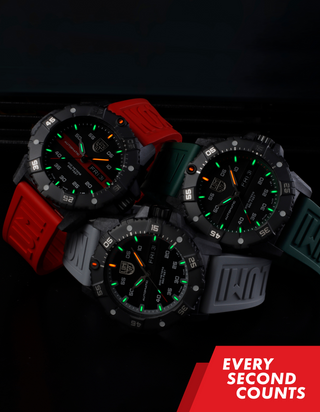Today, Alex Hibbert sets off on his second expedition in Svalbard. This journey will be a test of his fitness, efficiency and instinct honed over years of polar travel as he attempts to set the 24hr polar ski distance World Record - that is, the longest distance achieved by a skier in a polar region and with a virgin , natural snow surface.
A few weeks ago, Luminox attended his first world record attempt on the famed Arctic Circle Trail in Greenland, a 165km demanding route between the coastal Inuit community of Sisimiut and Kangerlussuaq. Unfortunately, he wasn't able to go on the trail due to the weather conditions. Here's a short recap of his time in Greenland: https://youtu.be/YaxQ-o8TIlg
Alex, what kind of obstacles were you facing in Greenland?
There had been massive dumps of snow, especially on the coast, in the weeks leading up to my arrival. The deep powder would have slowed my pace to a fifth of what I needed to finish on time. Although I had received these reports, and seen photographs of two-meter snow drifts in Sisimiut, my target, before flying out last month, I've seen the Arctic change so fast and dramatically in the past that I thought it was worth a shot . Because I had a fast, light, low-nose sledge, I needed to move along a trail – the sort that local Inuit hunters open each winter on dog sleds to access the hundreds of square miles of lakes and lowlands. This acted like a snow plow in the deep snow.
So, whilst the conditions were safe, by solo Arctic travel standards, it was a matter of timing. I could have spent two weeks or more manually opening the whole 165km route with my skis and sledge, but this would have made a mockery of the speed record attempt and caused me to miss commitments back in the UK. So, my sledge didn't have the capacity for two weeks of supplies.
Why not ski on a ski track? Wouldn't that minimize your risk?
In fact the world record for 24hrs on a ski track is over 260miles, believe it or not, but that not really my style and not how I travel. It's also not what I'm interested in or where my background comes from. So, I'm interested in traveling on virgin, natural Arctic polar conditions.
How much equipment did you take with you?
I was set up for pace, so had a low-profile trail sled and long narrow skis. These were key for my projected pace, and aside from that is was all about lightening my load. I only took basic emergency spare clothes, a tiny repair kit, one stove, daily rations, hot water flasks, my Luminox ICE-SAR 1003, no tent (just a sleeping bag, bivvy bag and shovel), and some lighting/camera/ Safety beacon gear. Oh, and lots of batteries for my head torch! The total weighed less than 25kg.
What's your most-used feature when you use your ICE-SAR 1003 outside?
This would probably be between the obvious selling point of full-time illumination, not needing prior exposure to daylight to 'charge up' the glowing tubes, and perhaps something less obvious. The face is sapphire crystal - supremely scratch-resistant and able to deflect everything I drag it through in the Arctic, from razor-like ice formations to handling sharp and abrasive expedition gear.
How much training does it take to prepare for such an expedition?
Training for a normal multi-week or even multi-month expedition usually revolves about getting to the start line strong, robust and with no niggling injuries from training. It's all about sustainability - giving your body the chance to survive seemingly endless day-long punishment in the harness. For very short, sharp-speed expeditions, much of that still stands. You need to be robust and feeling fresh, but a properly conditioned body is more likely to become apparent in performance. My run and cycle training is higher paced and with more sprint intervals, and I have little need to add extra muscle or general bulk to survive. This is more 'classic athlete' groundwork, and less like a long-distance expedition lead-up that's more like preparing for a siege!
Can we follow your process during your next expedition in Svalbard?
The answer is definitely yes – that's the fun bit.
I'm going to make sure that as I go along, every fifteen minutes or so, my location is going to be pinging out live on a website and you're going to be able to see exactly where I am. That also means that I'm going to be able to assess whether I'm going fast or slow in different sections and so can work out my progress myself as well as letting you guys see how I'm getting on.
Thank you Alex – and good luck for your second expedition in Svalbard!
You want to know more about Alex and his expeditions? Follow us and Alex on social media and join his races against the clock.
Meet Alex on Social Media:
https://twitter.com/alexhibbert
https://www.instagram.com/alexhibbert
Meet us on social media:


